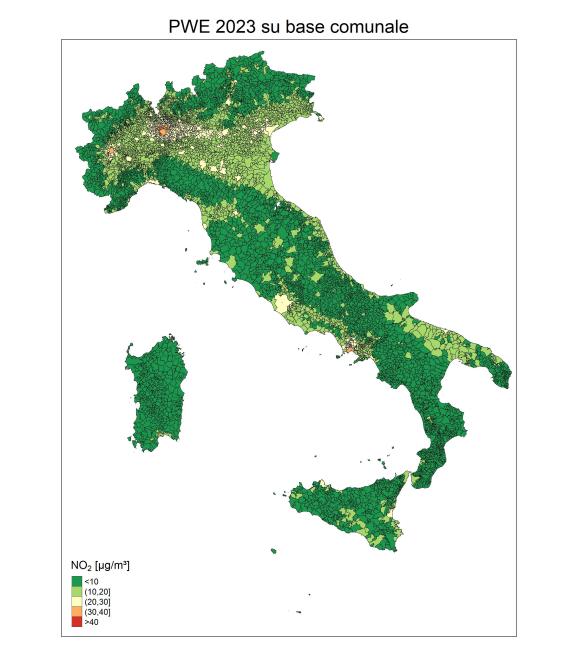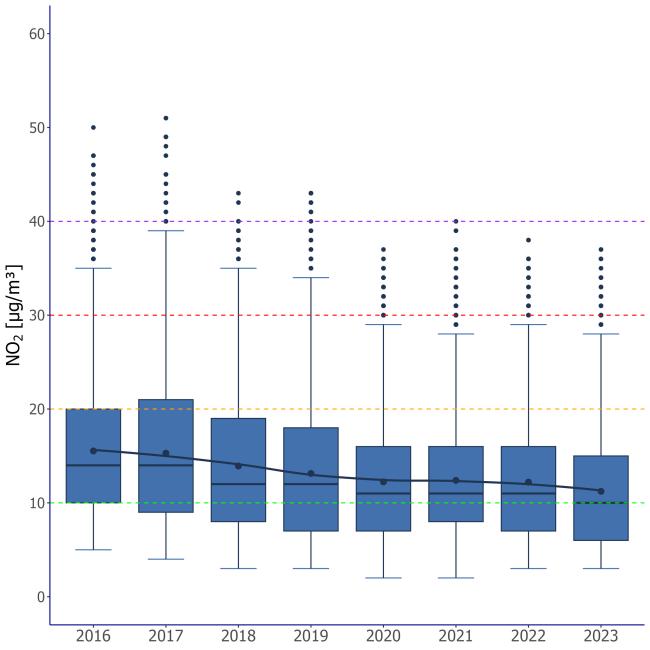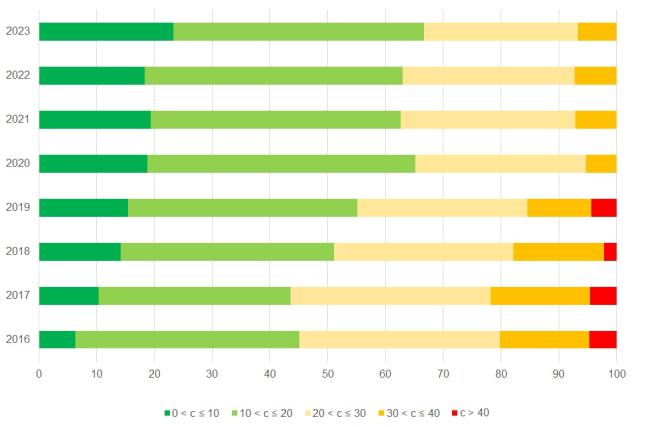Panel 1
Massimiliano BULTRINI, Simona BUSCEMI, Giorgio CATTANI, Alessandra GAETA, Federica NOBILE (Dipartimento di Epidemiologia del Servizio Sanitario Regionale-Regione Lazio ASL Roma 1), Maria Antonietta REATINI, Massimo STAFOGGIA (Dipartimento di Epidemiologia del Servizio Sanitario Regionale-Regione Lazio ASL Roma 1)
Estimates of annual population-weighted exposure (PWE) to nitrogen dioxide (NO₂), aggregated at municipal level, were produced using an integrated approach combining measurements and statistical modelling. The resulting data, covering the period 2016–2023, allow for comparison of PWE across all municipalities and provide a comprehensive national overview of average exposure levels.
In 2023, 77% of the population was exposed to concentrations above the WHO air quality guideline (10 µg/m³).
The national average PWE was 11 µg/m³ (minimum–maximum range: 3–37 µg/m³).
Over the period 2016–2023, there was an average 28% reduction in exposure levels, mainly attributable to a decline in road traffic emissions.
The most authoritative health estimates attribute a significant share of premature deaths and reduced life expectancy to exposure to air pollutants (WHO, 2016; EEA, 2022; WHO, 2021).
Assessing population exposure and its spatial and temporal variability in outdoor environments is a key step in epidemiological studies that investigate the relationship between air pollution and health effects (Caplin et al., 2019).
This indicator provides an estimate of the annual population-weighted exposure (PWE) to nitrogen dioxide (NO₂), aggregated at the municipality level, enabling comparisons between cities and offering a comprehensive national overview of average exposure.
It is representative of chronic exposure and is useful for estimating long-term health impacts.
Exposure levels are compared with the reference values (guideline levels and interim targets) set by the World Health Organization (WHO, 2021).
Estimate the average population exposure to the main airborne pollutants, assess exposure levels against WHO reference values, and evaluate the temporal trends in population exposure.
Legislative Decree No. 155 of 13 August 2010, as amended, transposing Directive 2008/50/EC and Directive 2004/107/EC.
WHO (2021), Global Air Quality Guidelines: Particulate matter (PM10, PM2.5), ozone, nitrogen dioxide, sulfur dioxide and carbon monoxide. Geneva, World Health Organization, 2021.
A Clean Air Programme for Europe, Brussels, 18.12.2013, COM(2013) 918 final.
A Europe that protects: Clean air for all, Brussels, 17.5.2018, COM(2018) 330 final.
Pathway to a Healthy Planet for All – EU Action Plan: “Towards Zero Pollution for Air, Water and Soil”, Brussels, 12.5.2021, COM(2021) 400 final.
As part of the revision of its Air Quality Guidelines, the World Health Organization (WHO) has provided quantitative risk estimates for a range of health effects associated with an increase of 10 µg/m³ in the annual average concentration of various pollutants. The WHO does not define a threshold below which there is no risk but identifies an annual average concentration of 10 µg/m³ for nitrogen dioxide (NO₂) as the air quality guideline level – the lowest level for which increases in total mortality, cardiopulmonary mortality and lung cancer mortality were observed, with a 95% confidence interval.
The WHO also introduced interim targets – higher reference levels to be used as progressive policy milestones toward the final guideline value. For NO₂, the WHO proposes the following interim targets:
-
IT-3: 20 µg/m³
-
IT-2: 30 µg/m³
-
IT-1: 40 µg/m³
EU policy objectives for clean air aim to progressively align with WHO air quality guidelines, which are significantly stricter than current EU air quality standards and are based on levels deemed necessary to ensure effective protection of human health.
The EU Clean Air Policy Package and the Zero Pollution Action Plan set the objective of reducing the number of premature deaths attributable to air pollution by more than 50% by 2030, compared to 2005 levels.
Panel 2
Caplin A., Ghandehari M., Lim C., Glimcher P., Thurston G. (2019) Advancing environmental exposure assessment science to benefit society. Nature communication (2019) 10:1236. https://doi.org/10.1038/s41467-019-09155-4.
EEA (2022), Health Risk Assessment of Air Pollution and the Impact of the New WHO Guidelines. Eionet Report – ETC/ATNI 2022/10.
EUROSTAT(2022), Sustainable development in the European Union — Monitoring report on progress towards the SDGs in an EU context — 2022 edition. (DOI): 10.2785/313289.
WHO (2016), Ambient air pollution: A global assessment of exposure and burden of disease. Geneva, World Health Organization, 2016.
WHO (2021), Global Air Quality Guidelines. Particulate matter (PM10, PM2.5), ozone, nitrogen dioxide, sulfur dioxide and carbon monoxide. Geneva, World Health Organization, 2021.
Stafoggia M, Bellander T, Bucci S et al. Estimation of daily PM10 and PM2.5 concentrations in Italy, 2013-2015, using a spatiotemporal land-use random-forest model. Environ Int 2019;124:170-79.
Stafoggia M, Cattani G, Ancona C, Ranzi A. (2021) La valutazione dell’esposizione della popolazione italiana all’inquinamento atmosferico nel periodo 2016-2019 per lo studio della relazione tra inquinamento atmosferico e COVID-19. Epidemiol Prev. 2021 Sep-Dec;44(5-6 Suppl 2):161-168. Italian. doi: 10.19191/EP20.5-6.S2.115. PMID: 33412807.
The population considered is the one distributed across the 2021 census sections, which represent the most recent territorial reference available.
The indicator expresses a municipality-level average of population exposure. It is well known that within a single municipality, there may be spatial variability in pollutant concentrations, with some areas experiencing higher levels than the municipal average or background concentrations. However, the assessment of local- or microscale-level exposure within individual municipalities falls outside the scope of this indicator.
It is important to note that areas with higher population density within a municipality are given greater weight in the calculation of the Population Weighted Exposure (PWE).
In any case, the exposure values obtained should not be compared with legal limit values: for the purpose of compliance assessment with legal thresholds, the highest value measured by individual air quality monitoring stations should be used instead.
Application of high-resolution spatiotemporal models, using spatiotemporal predictors, satellite data, and air quality monitoring data.
Data quality assessment
DEP: Dipartimento di Epidemiologia del SSR Regione Lazio - ASL RME ISPRA (Istituto Superiore per la Protezione e la Ricerca Ambientale)
ISTAT (Istituto Nazionale di Statistica)
SNPA (Sistema Nazionale per la protezione dell’ambiente)
ISPRA - Database InfoARIA
ISTAT - www.demo.istat.it
National, Regional and Municipal level (7,901 out of 7,914 municipalities)
2016-2023
Indicator assessment
The model uses daily average concentrations measured at air quality monitoring stations across the national territory as the response variable, and a selection of spatial and temporal predictors as explanatory variables. Monitoring data are collected and stored by ISPRA in the InfoAria database, in accordance with Directive 2008/50/EC (and its national transposition by Legislative Decree No. 155/2010) and Decision 2011/850/EU.
A machine learning model—random forest—was developed to relate daily pollutant concentrations from monitoring stations to spatial predictors (such as population density, road network, land cover, altitude, artificial surfaces, etc.) and spatiotemporal predictors (dispersion modelling, meteorological data), in order to estimate daily mean NO₂ concentrations for each 1 km² grid cell across the Italian territory.
Based on the daily concentration estimates from the random forest model, the annual population-weighted exposure to NO₂ was calculated by weighting the concentration values in each grid cell by the population residing in that cell.
The “national average concentration value” is computed as the population-weighted mean of the estimated concentrations at the municipal level, using the resident population as weights.
Lastly, the percentage distribution of the resident population exposed to different NO₂ concentration classes is estimated.
In 2023, 77% of the population was exposed to concentrations of PM10 exceeding the WHO air quality guideline value (10 µg/m³); 33% was exposed to levels above the interim target IT-3 (20 µg/m³); and 7% of the population residing in 31 municipalities was exposed to concentrations exceeding IT-2 (30 µg/m³).
In the latter case, the exposed population was predominantly located in the regions of Piedmont, Lombardy, and Campania, particularly in the municipalities of Turin and Naples, as well as in municipalities within the metropolitan area of Milan and the province of Monza and Brianza (Figure 1 – Table 1).
No municipality recorded PM10 levels exceeding the interim target IT-1 (40 µg/m³) in 2023.
The national average PM10 concentration, considering all Italian municipalities, was 11 µg/m³ (minimum–maximum range: 3–37 µg/m³) (Figure 2).
As shown in Figure 2, over the eight-year period considered, there is an overall decreasing trend in population-weighted exposure (PWE) values.
The national average decreased from 16 µg/m³ in 2016 to 11 µg/m³ in 2023, representing a 28% reduction over the observed period.
Although the year 2020 may have been influenced by lockdown measures implemented to contain the spread of the COVID-19 pandemic, the overall trend appears consistent across the years and is primarily attributed to the reduction in road traffic emissions.
While the trend has not been quantitatively assessed using statistical methods and refers to a relatively short time frame, it aligns with the patterns observed over the past decade at air quality monitoring stations.
The proportion of the population exposed to NO₂ concentrations below the WHO recommended threshold increased from 6% in 2016 to 23% in 2023.
At the same time, in 2023 — as in the previous three years — PWE did not exceed the value of 40 µg/m³ (Figure 3).
Data
Figure 2: Annual distribution of Population-Weighted Exposure (PWE) to Nitrogen Dioxide (NO₂) at Municipal Level
ISPRA processing based on data from the Epidemiology Department of the Lazio Regional Health Service
The box represents the interquartile range (IQR), which is the difference between the third quartile (Q3, 75th percentile) and the first quartile (Q1, 25th percentile) of the data. The line inside the box indicates the median (Q2, 50th percentile), while the dot represents the mean value.
Figure 3: Percentage of Population Exposed to Nitrogen Dioxide (NO₂) by exposure range and year
ISPRA processing based on data from the Epidemiology Department of the Lazio Regional Health Service
The five PWE classes correspond respectively to the WHO air quality guideline value and the three interim targets.
Table 1: Nitrogen Dioxide (NO₂) – Population-Weighted Exposure (PWE) by region: Percentage distribution by exposure range (2023)
ISPRA processing based on data from the Epidemiology Department of the Lazio Regional Health Service
PWE: Population Weighted Exposure
The five PWE classes correspond respectively to the WHO air quality guideline value and the three interim targets.



The indicator is aligned with those used at the European level by the European Environment Agency (EEA) and globally by the World Health Organization (WHO) to monitor population exposure.
Moreover, it serves as the basis for exposure assessment in the development of health risk assessments and burden of disease evaluations, in accordance with the methodologies adopted by both supranational organizations.
With reference to the United Nations Sustainable Development Goals (SDGs), the methodological approach is consistent with that used to calculate the indicator for monitoring progress towards Goal 11 ("Make cities and human settlements inclusive, safe, resilient and sustainable"), specifically Target 11.6 ("By 2030, reduce the adverse per capita environmental impact of cities, including by paying special attention to air quality and municipal and other waste management").
From a methodological standpoint, the exposure estimate also provides the foundation for one of the indicators used to monitor progress towards Goal 3 ("Ensure healthy lives and promote well-being for all at all ages"), specifically Target 3.9 ("By 2030, substantially reduce the number of deaths and illnesses from hazardous chemicals and air, water and soil pollution and contamination").